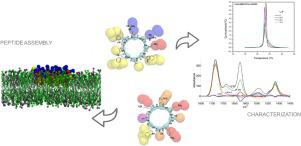Colloids and Surfaces B: Biointerfaces ( IF 5.8 ) Pub Date : 2020-09-09 , DOI: 10.1016/j.colsurfb.2020.111349 Bárbara Claro 1 , Eva González-Freire 2 , Martin Calvelo 2 , Lucinda J Bessa 3 , Erik Goormaghtigh 4 , Manuel Amorín 2 , Juan R Granja 2 , Rebeca Garcia-Fandiño 5 , Margarida Bastos 1

|
The search of new antibiotics, particularly with new mechanisms of action, is nowadays a very important public health issue, due to the worldwide increase of resistant pathogens. Within this effort, much research has been done on antimicrobial peptides, because having the membrane as a target, they represent a new antibiotic paradigm. Among these, cyclic peptides (CP) made of sequences of D- and L-amino acids have emerged as a new class of potential antimicrobial peptides, due to their expected higher resistance to protease degradation. These CPs are planar structures that can form Self-assembled Cyclic Peptide Nanotubes (SCPNs), in particular in the presence of lipid membranes. Aiming at understanding their mechanism of action, we used biophysical experimental techniques (DSC and ATR-FTIR) together with Coarse-grained molecular dynamics (CG-MD) simulations, to characterize the interaction of these CPs with model membranes of different electrostatic charges’ contents. DSC results showed that the CPs show a strong interaction with negatively charged membranes, with differences in the strength of interactions depending on peptide and on membrane charge content, at odds with no or mild interactions with zwitterionic membranes. ATR-FTIR showed that the peptides self-assemble at the membrane surface, adopting mainly a β-structure. The experiments with polarized light showed that in most cases they lie parallel to the membrane surface, but other forms and orientations are also apparent, depending on peptide structure and lipid:peptide ratio. The nanotube formation and orientation, as well as the dependence on membrane charge were also confirmed by the MD simulations. These provide detail on the position and interactions, in agreement with the experimental results. Based on the findings reported here, we could proceed to the design and synthesis of a second-generation CPs, based on CP2 (soluble peptide), with increased activity and reduced toxicity.
中文翻译:

靶向抗菌环肽纳米管的膜–实验与计算研究
由于抗药性病原体在全球范围内的增加,如今寻找新的抗生素,尤其是具有新的作用机制的新抗生素,已成为一个非常重要的公共卫生问题。在这一努力中,已经对抗菌肽进行了很多研究,因为以膜为靶标,它们代表了一种新的抗生素范例。其中,由于D-和L-氨基酸序列组成的环肽(CP)对蛋白酶降解的抵抗力更高,因此已成为一类潜在的抗菌肽。这些CP是可以形成自组装环肽纳米管(SCPN)的平面结构,特别是在脂质膜存在的情况下。为了了解他们的行动机制,我们使用生物物理实验技术(DSC和ATR-FTIR)以及粗粒度分子动力学(CG-MD)模拟,来表征这些CP与不同静电荷含量的模型膜之间的相互作用。DSC结果表明,CP显示出与带负电的膜的强相互作用,相互作用强度取决于肽和膜电荷含量,与两性离子膜没有或有轻微的相互作用。ATR-FTIR表明这些肽在膜表面自组装,主要采用β结构。偏振光实验表明,在大多数情况下,它们与膜表面平行,但其他形式和方向也很明显,具体取决于肽的结构和脂质与肽的比例。MD模拟也证实了纳米管的形成和取向以及对膜电荷的依赖性。这些提供与实验结果一致的位置和相互作用的详细信息。根据此处报道的发现,我们可以继续设计和合成基于CP2(可溶性肽)的第二代CP,具有增强的活性和降低的毒性。



























 京公网安备 11010802027423号
京公网安备 11010802027423号